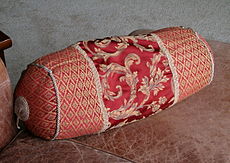A pillow is a soft cushion that a person puts under their head when they are sleeping in a bed.


A pillow is made from two pieces of cloth that are sewn together and stuffed with a soft material, such as feathers, duck down, or synthetic batting (man made soft stuffing). Pillows are usually rectangular. Pillows are covered with a fabric sheet called a pillowcase. The pillowcase protects the pillow from getting dirty.
The word pillow comes from Middle English pilwe, from Old English pyle (akin to Old High German pfuliwi) and from Latin pulvinus. The word pillow was first known to be used before the 12th century.[1]
History
changeThere is no clear inventor of the pillow. Millions of years ago, animals learned to use pillows. An early example is monkeys resting their heads on their arm.[2] Many animals, including birds, use wood and stone nests as pillows.[2] Many domesticated animals have also learned to make use of human-made pillows and cushions. They also rest on members of their own and other species for the same reason.[2]
Mesopotamia and ancient Egypt
changeIn ancient Mesopotamia, people slept on stone pillows. Pillows were a status symbol.[3] Early pillows were rectangular and had grooves shaped for the head. Pillows showed the wealth of a person — the more a person owned the wealthier they were.[3]
Anicent Egyptians used pillows as a solution to back, neck and shoulder pain. They also prevented insects from crawling in their hair, mouth or nose at night.[3] Anicent Egyptian pillows were made out of wood and stone and looked like stands. These pillows were mostly used for the deceased.[4]
References
change- ↑ "Definition of PILLOW". www.merriam-webster.com. Retrieved 2022-10-22.
- ↑ 2.0 2.1 2.2 Sanz, Crickette M.; Call, Josep; Boesch, Christophe (2013-03-07). Tool Use in Animals: Cognition and Ecology. Cambridge University Press. ISBN 978-1-107-01119-9.
- ↑ 3.0 3.1 3.2 Writer, Staff (2015-08-04). "Who Invented the First Pillow?". Reference.com. Retrieved 2022-10-22.
- ↑ Seath, J.; Giże, A. P.; David, A. R.; Hall, K.; Lythgoe, P.; Speak, R.; Caldwell, S. (2006-04-01). "An atypical Ancient Egyptian pillow from Sedment el-Gebel: evidence for migrant worker trading and technology". Journal of Archaeological Science. 33 (4): 546–550. doi:10.1016/j.jas.2005.09.014. ISSN 0305-4403.